Chloé Perdrix writes: primary care in Thailand, Laos and Cambodia.
 My name is Chloé Perdrix, I’m a 27 year old French GP resident,. I am taking a sabbatical year travelling around Asia. In order to stay in touch with the medical network, I intend to meet general practitioners during this journey. I proposed to WONCA and the Vasco da Gama Movement (VdGM), to write an article each two months in order to share my discoveries, my questions and my reflections about this experience. This is my third story.. to see others click here.
My name is Chloé Perdrix, I’m a 27 year old French GP resident,. I am taking a sabbatical year travelling around Asia. In order to stay in touch with the medical network, I intend to meet general practitioners during this journey. I proposed to WONCA and the Vasco da Gama Movement (VdGM), to write an article each two months in order to share my discoveries, my questions and my reflections about this experience. This is my third story.. to see others click here.
Meeting the WONCA secretariat in Bangkok
Thailand is a very touristy country, and it was difficult to have real contact with the Thai population.
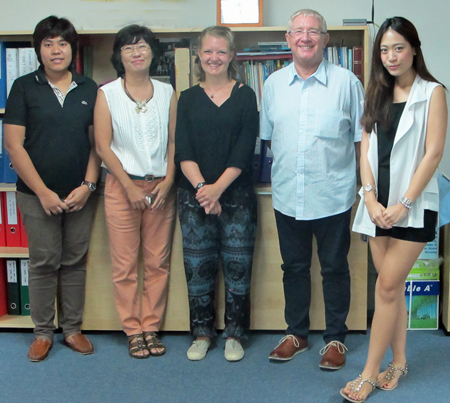
The most interesting thing I did relating to primary care in Thailand was to meet WONCA’s secretariat, Dr Garth Manning and team, over lunch. What an adventure to get to the meeting ! We had to cross Bangkok by taxi and even though we left the hotel one hour before the meeting time, we arrived late because of a crazy traffic jam! After arriving in the area, we had to wait 10 minutes (no less, no more) to cross a road ! With so much traffic, and so little space for walkers, Bangkok is very different from the peaceful island where we were just before. But some people say that when you live in Bangkok for a while, you finally like it very much. It is just a matter of knowing the good places.
Finally we reached our destination. Dr Manning and his team were very welcoming. We shared about our health care systems. Then, we took pictures (l to r: Anuta 'Bee' Mustafa, Nongluck Suwisith, Chloé Perdrix, Dr Garth Manning, Arisa Puissarakij) to immortalise the moment, and went to have lunch in a very good Thai restaurant. It was a lovely time. Having lunch with WONCA’s team was an honour for me. I thank them a lot for having taken time from their busy WONCA schedule to look after us.
Urban family medicine in Laos
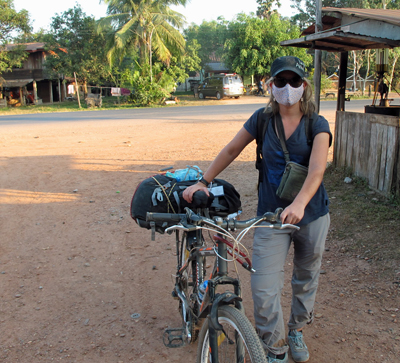
After Thailand, a new adventure began. We decided to go to Vientiane, capital of Laos and buy two bikes to cycle along Mekong river to its delta, in Vietnam. This represents about 2,000 km (1,240 miles).
Photo:
How to protect you skin in Laos (no suncream there)
First, some words about Laos.
Laos’ population is 7.77 million inhabitants. The life expectancy at birth is 67.81 years old and the average net salary is $107 per month. (the Asian average net salary is $442, and world average net salary is $850)(1). The population is 70% rural dwelling.
We spent Christmas in Savannakhet, one of the main cities in Laos. There, I visited the local hospital with my brother Romain and one of the nurses explained the organisation in the hospital.
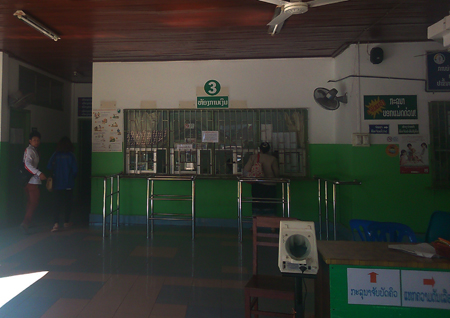
For current diseases, chronic diseases, monitoring and prevention, there is a special department in the hospital - the Outpatient Department (OPD). (
Photo: OPD in Savannaket, Laos). It is like a health centre with different rooms for consultations including minor surgery, female examinations, venepuncture, vaccinations, and monitoring of children. If needed, general practitioners can easily send patients to the emergency room or other speciality departments in the hospital.
The monitoring of chronic diseases clinics are every Tuesday and Thursday. Diabetes and hypertension are common chronic diseases, caused in the nurse’s opinion by sticky rice. (Sticky rice is a very special Laotian rice used as bread is in France).
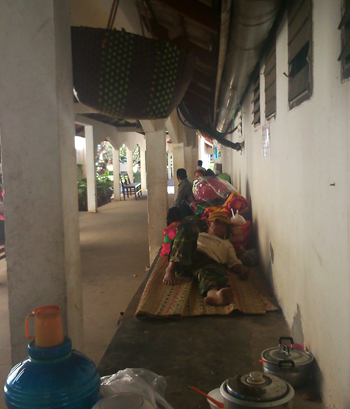 Photo Patients waiting in the hospital (Savannaket, Laos).
Photo Patients waiting in the hospital (Savannaket, Laos).
Shamanism
To understand the Laotian view of disease, I will talk about Shamanism as Laotians practice Shamanism in parallel of occidental medicine.
They attribute illness to a spirit (
Phi) intervention : disease would be caused by the departure of a protector spirit (
Phi Khoun) from the body. To recover, laotians ask Shamans (healers), who can sometimes also be doctors, to organize a celebration named
Baci.
Shamans have access to spirits and are able to find the lost ones and reintegrate them into the sick person’s body. One can become a Shaman after having faced a serious illness which led to the edge of the death world. Laotians think that this experience of proximity of death makes the spirits choose a person to become Shaman. During the celebration, Shamans sit down, straddling a chair to imitate riding a horse, wear a black mask to hide from real world and sing to find the spirit.
Rural Health Centres in Cambodia
After a wonderful New Year’s Eve in an amazing place named the 4000 Mekong islands, next to the border, we arrived in Cambodia.
Then, we decided to cycle 400 km more to visit the Angkor temples (which were spectacular, but that is not the subject of this article). On the way, we camped in a health centre area for a night because there was no guesthouse/hostel around (see photo at left). We talked to the midwife and the nurse who were on duty. There was no doctor at this centre – only nurses and midwives.
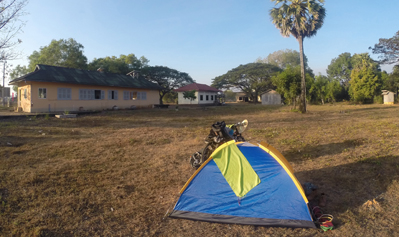
The nearest place with a doctor was 50 minutes away by car – quicker for one year now, thanks to a new road (previously it took 30 minutes more). When there is an emergency, they don’t have ambulance, so they call a taxi to drive the patient to a doctor. The health centre follows pregnant women and does about 15 deliveries per year.
The nurse, Tearah, invited us for a delicious Cambodian dinner on the health centre’s terrasse. At the same time, a woman was giving birth in the health centre. I proposed my help if the mother or baby had any problem. Fortunately, both of them were ok after delivery, and the midwife didn’t ask me for help. We heard the first baby cries. His father, grandmother, and older sister looked so happy !
Nap times during work in Laos and Cambodia
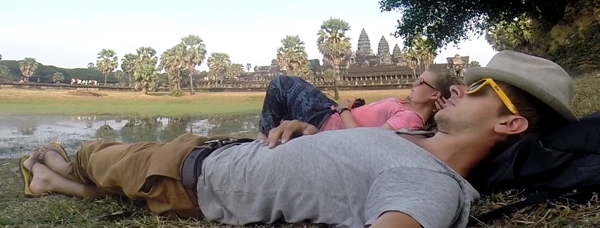
During our bike trip in the countryside, we could often see roadside shop owners as well as supermarket sales persons laying down in a hammock or a bed situated in the middle of the shop. They are not ashamed of that at all, on the contrary, it seems very normal for everybody.
I imagined how life would be in Europe if naps were allowed during work. A lot of private companies have already created some rooms dedicated to employees’ naps. Knowing that doctors themselves have a high rate of burnout, would implementing a short nap time improve medical staff working conditions?
(photo of us napping at Angkor Wat)
I would be curious to read your reactions about this point.
Of course, it seems important to point out that working conditions in Laos and Cambodia cannot be reduced to this nap time only. Indeed, some working conditions are terrible. Prostitution in Cambodia, child labour, poor conditions of women in the garment industry... and the list goes on.
Cycling & Health
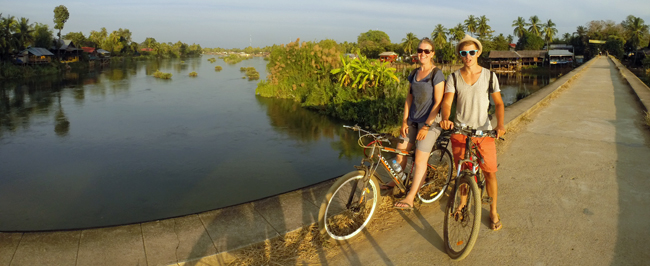
And to finish, I would recommend everyone to bike ! It is so healthy ! It improves physical and mental health and reduces the risks of many chronic diseases.(2)(3) It makes you feel better in your body and think about life during long hours (Yes, it’s like a psychotherapy). Furthermore, it makes you strive to overcome your limits. And one of the best part is, even though you eat a lot, you get thinner.
Next time, I will talk about Cambodia and Vietnam.
Happy new year to all. I wish you the best in your life.
Cheers
Chloé.
1. Salaire au Laos [Internet]. [cité 27 déc 2014]. available at:
http://www.journaldunet.com/business/salaire/laos/pays-lao
2. Physical Activity Guidelines Advisory Committee. Physical Activity Guidelines Advisory Committee Report. Washington DC: DHHS, 2008.
3. WHO. Global recommendations on physical activity for health. Geneva: WHO, 2010.